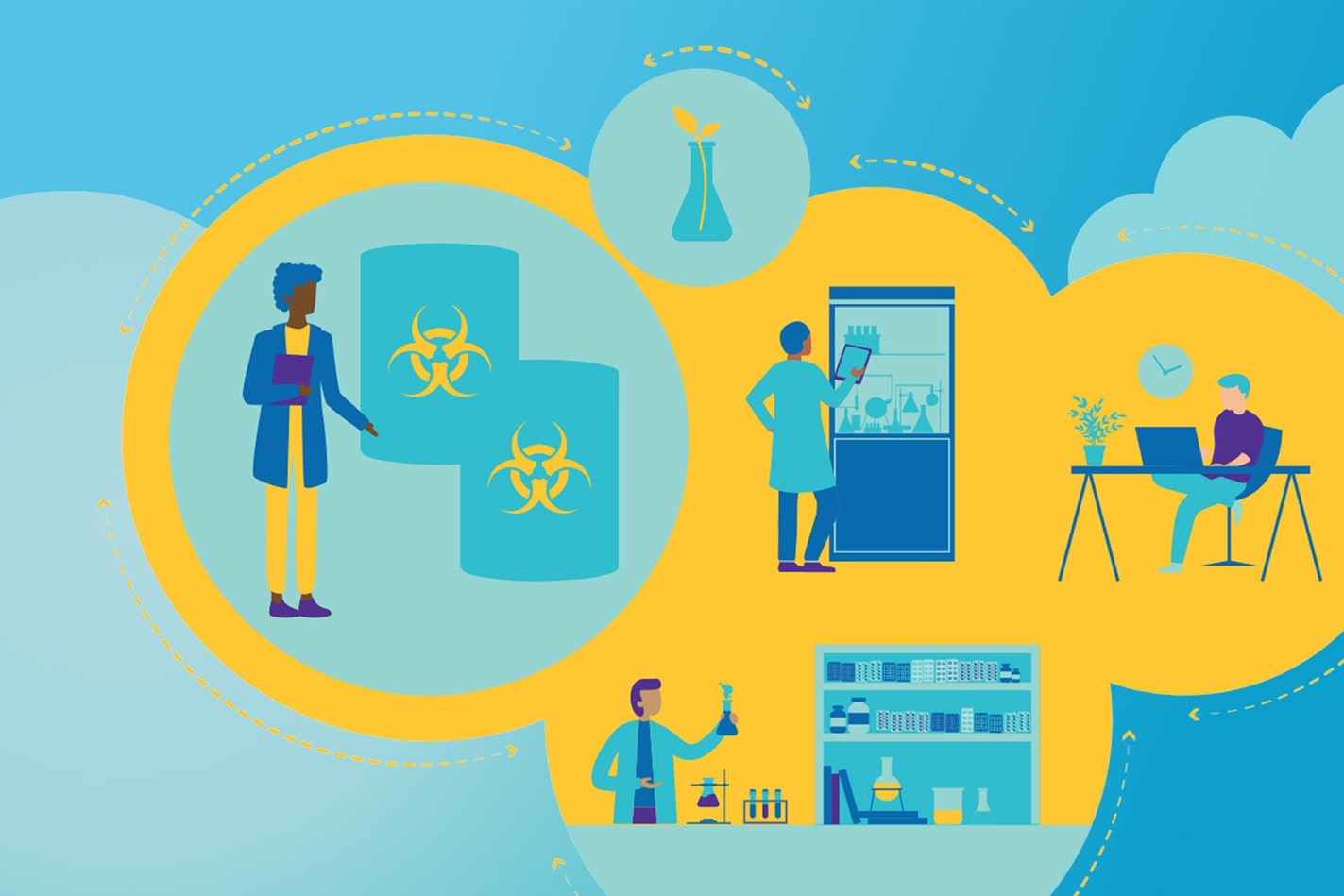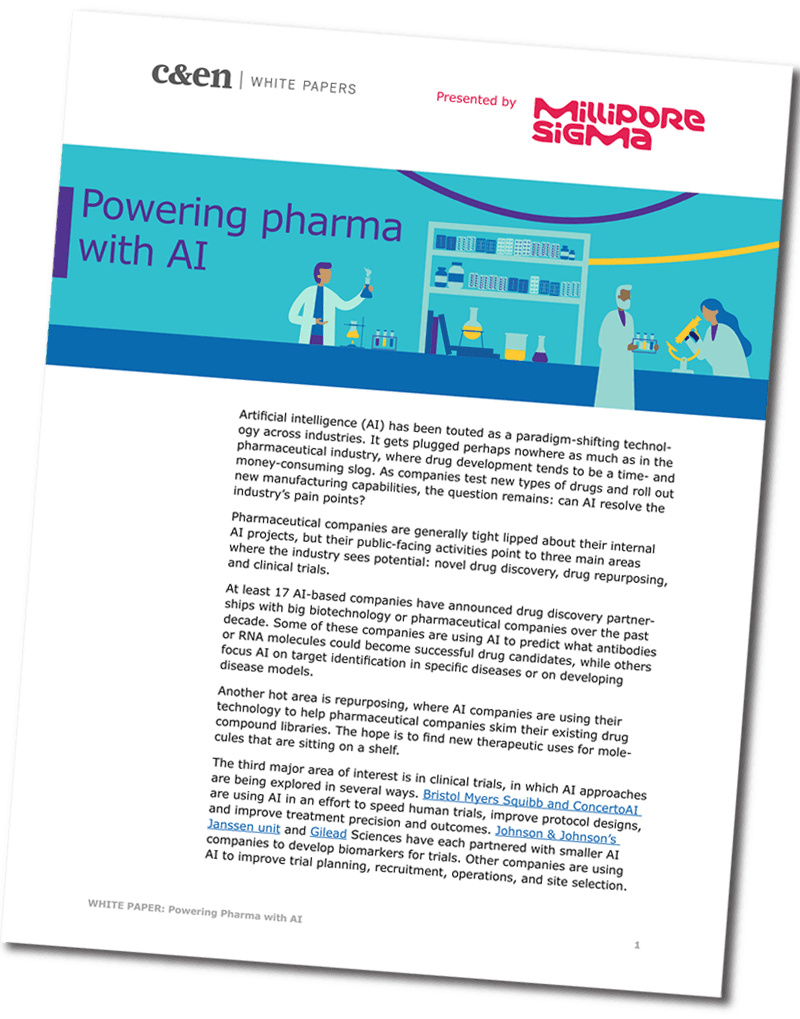Remote
Control
The COVID-19 pandemic reveals the need for lab data solutions
By Farooq Ahmed, C&EN BrandLab Contributing Writer
O ne year into the COVID-19 pandemic, only half the employees at a petrochemical facility in Texas report into work. Before they do, they answer questionnaires about their overall health. If they have symptoms—a fever, loss of taste or smell, a cough—they must remain at home.
Those who arrive on-site find a changed workplace. They minimize interactions with colleagues and practice social distancing to help prevent catching the novel coronavirus or endangering the health of others.
The pandemic has challenged scientists, engineers, and their organizations in ways they have never experienced. But employees had different roles to play in meeting those challenges. In most countries, scientific enterprises were deemed “essential.” Staff could return to workplaces if companies abided by local safety regulations for capacity, distancing, and symptom monitoring. But this often meant that senior staff members and higher-level managers who perform computerized tasks, like data analysis, remained at home, while key technical and other staff went on-site to operate instruments, manage inventory, and conduct experiments.
For professionals involved in storing, managing, or making decisions based on scientific data, the global health crisis has demonstrated the crucial importance of laboratory data management systems that bridge this divide. Such systems allow the capture of data from any instrument, the transformation of that data into actionable intelligence, and the safe sharing of that information with colleagues—from any location around the world.
“COVID has acted as a trigger,” says Annette Hellbach, the head of science enablement tools at MilliporeSigma’s Connected Lab. “It has accelerated the transition to high-quality lab data management systems. Those who already had a good system in place were the lucky ones.”
A senior research chemist at the Texas petrochemical plant, who asked not to be identified because he was not authorized to speak on behalf of his company, says their lab data management system helped facilitate interactions between employees who worked off-site and those at the facility. “We already had a decent percentage of people pulling data remotely,” he says. For them, the switch to working from home was nearly seamless. “We had some issues with data transfer, but it was limited,” he adds.
In the late summer of 2020, C&EN BrandLab surveyed readers on behalf of MilliporeSigma to learn how professionals manage and use lab data. Respondents in the for-profit and government sectors said the COVID-19 pandemic had influenced their thoughts on digital lab data management, with one-third changing their view on the need for a comprehensive system. Sixty-one percent of those said that they now needed access to data from anywhere on any device. Respondents also noted the increased importance of sharing data with internal and external partners—especially data on the virus, its spread, and vaccine development.
Comprehensive Systems
Of the many disruptions caused by the pandemic, the abrupt shift to employees working from home had the potential to hamstring an organization’s productivity. A comprehensive lab data management system has allowed many companies to avoid significant interruptions associated with this transition.
Arne Kusserow, a product manager for BSSN™ Software at MilliporeSigma, points out some of the benefits of having a robust system. “Even if some people cannot be in the lab and are working from home, a system like BSSN allows them to standardize the file output from multiple instruments, access full data sets, analyze that information together with other data from existing systems in the lab, and to share that data with others inside or outside of their organization,” Kusserow says. “They can do all this from their couch.”
BSSN, which was acquired by MilliporeSigma in August 2019, offers a software suite built with the open source Analytical Information Markup Language (AnIML). It is designed specifically to handle and standardize scientific data and works seamlessly with the open Standardization in Lab Automation (SiLA) communication protocol for lab instruments.
Market research on the pandemic’s effects on lab data management systems reflects a heightened interest in the systems. An August 2020 market research report by Technavio predicted a 9% compound annual growth rate over the next 5 years in the lab information management system sector—an increase spurred in part by greater demand for such software.
Sharing is Collaborating
Vladimir Khlebnikov is a senior research scientist at General Intermediates of Canada, a manufacturer of small molecules often used as precursors in pharmaceutical production. Proper preparation has helped his company survive the worst of the pandemic’s challenges, according to Khlebnikov. “Planning seems more important than ever,” he says, “especially when we need special analytical data from third parties.”
Indeed, one of the weaknesses COVID-19 has exposed is sharing data with those outside an organization. While sharing is often easy between internal groups—usually accomplished by adjusting file permissions—doing so with external partners has proved more difficult.
Pat Hanrahan, a regulatory and quality manager at GlaxoSmithKline’s facility in the UK, agrees. “The pandemic has shown internal lab and data management systems to be robust and resilient,” he says. “Where things have fallen down is with external partners—contract manufacturing organizations, in particular—where it has been very difficult to access normally easily accessible data.”
A number of factors account for this disconnect, Hanrahan says. Many of the people he used to request data from have been furloughed and their workload has been passed onto other colleagues, who are now overburdened.
In addition, not all companies have deployed adequate virtual private networks (VPNs) to allow employees quick and remote access to information. With already-stretched information technology infrastructures, Hanrahan says, “partners are not sharing access to their data in real time as they might when most people are working on-site.”
The pandemic has shown internal lab and data management systems to be robust and resilient.
Regulatory and Quality Manager at GlaxoSmithKline
MilliporeSigma’s Hellbach says her team is developing a number of approaches, including a tool for BSSN that allows pharmaceutical companies and external partners like contract research organizations to exchange information securely. “The data resides within one company with reliable authentication authorization systems and audit trailing to ensure a secure environment,” she says. “With that, data sharing becomes easy.”
In this way, companies can deepen their relationships with their partners. General Intermediates’ Khlebnikov welcomes such developments. “We depend on collaborations with many partners,” he notes, adding that inefficiencies in collaborations are the major reason for any pandemic-related delays his company has experienced.
“We have found that good communication with suppliers and partners, as well as a diversified supply chain, has helped us avoid suffering huge disruptions,” Khlebnikov says. With all the firm had to contend with, he says, it was fortunate to have an efficient data management system in place.




